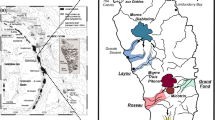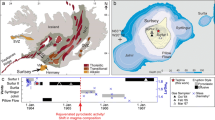Abstract
Major oxide, trace element and volatile (H2O, CO2, S, F, and Cl) compositions have been analyzed for olivine-hosted melt inclusions in eight basalt samples from Yellowstone National Park and the Snake River Plain (SRP) to identify the least differentiated melt compositions and assess the volatile budget of the Yellowstone hotspot. Melt-inclusion chemistry was evaluated to understand potential overprinting effects in the shallow mantle and crust of magmas derived from deeper levels. Maximum water concentrations of 3.3 wt% and CO2 up to 1,677 ppm have been observed in olivine-hosted melt inclusions from the Gerritt Basalts at Mesa Falls, Idaho (SRP region), which is significantly higher than the maximum concentrations measured in lavas from other hotspots such as Hawaii (~0.8–0.9 wt%). Maximum water concentrations were generally observed in the least differentiated melt inclusions in terms of incompatible major oxide concentrations, indicating that high water concentrations are characteristic of the mantle or perhaps lower crust rather than resulting from differentiation enhancement within the shallow crust, even taking into account the fact that water behaves as an incompatible element during crystal fractionation. Enrichment in Ba coupled with depletion in Th in many of the melt inclusions and their host rocks is a characteristic of many arc lavas and may indicate that volatiles in Yellowstone-Snake River Plain basalts could have a subduction zone origin.











Similar content being viewed by others
References
Bonnichsen B, Leeman WP et al (2008) Miocene silicic volcanism in southwestern Idaho: geochronology, geochemistry, and evolution of the central Snake River Plain. Bull Volcanol 70(3):315–342
Camp VE (1995) Mid-miocene propagation of the yellowstone mantle plume head beneath the Columbia River Basalt source region. Geology 23(5):435–438
Camp VE, Ross ME (2004) Mantle dynamics and genesis of mafic magmatism in the intermontane Pacific Northwest. J Geophys Res Solid Earth 109(B8)
Carlson RW (1984) Isotopic constraints on Columbia River Flood-Basalt Genesis and the Nature of the Subcontinental Mantle. Geochim Cosmochim Acta 48(11):2357–2372
Castro MC, Ma L et al (2009) A primordial, solar He-Ne signature in crustal fluids of a stable continental region. Earth Planet Sci Lett 279(3–4):174–184
Chen Y, Zhang Y (2008) Olivine dissolution in basaltic melt. Geochim Cosmochim Acta 72(19):4756–4777
Christiansen RL (2001) The quaternary and Pliocene Yellowstone Plateau volcanic field of Wyoming, Idaho, and Montana
Christiansen RL, Foulger GR et al (2002) Upper-mantle origin of the Yellowstone hotspot. Geol Soc Am Bull 114(10):1245–1256
Churikova T, Worner G et al (2007) Volatile (S, Cl and F) and fluid mobile trace element compositions in melt inclusions: implications for variable fluid sources across the Kamchatka arc. Contrib Mineral Petrol 154(2):217–239
Craig H (1993) Yellowstone hotspot; a continental mantle plume. Eos Trans Am Geophys Union 74:602
Craig H, Lupton JE et al (1978) Helium isotope ratios in Yellowstone Park and Lassen Park Volcanic gases. Geophys Res Lett 5(11):897–900
Danyushevsky LV, McNeill AW et al (2002) Experimental and petrological studies of melt inclusions in phenocrysts from mantle-derived magmas: an overview of techniques, advantages and complications. Chem Geol 183(1–4):5–24
Danyushevsky LV, Leslie RAJ et al (2004) Melt inclusions in primitive olivine phenocrysts: the role of localized reaction processes in the origin of anomalous compositions. J Petrol 45(12):2531–2553
Demouchy S, Mackwell S (2003) Water diffusion in synthetic iron-free forsterite. Phys Chem Minerals 30(8):486–494
Dixon JE, Stolper EM et al (1995) An experimental study of water and carbon dioxide solubilities in mid ocean ridge basaltic liquids. 1. Calibration and solubility models. J Petrol 36(6):1607–1631
Feeley TC (2003) Origin and tectonic implications of across-strike geochemical variations in the Eocene Absaroka volcanic province, United States. J Geol 111(3):329–346
Foley S (1992) Vein-Plus-Wall-Rock melting mechanisms in the lithosphere and the origin of Potassic Alkaline Magmas. Lithos 28(3–6):435–453
Geist D, Richards M (1993) Origin of the Columbia Plateau and Snake River plain: deflection of the Yellowstone plume. Geology 21(9):789–792
Graham DW, Reid MR, Jordan BT, Grunder AL, Leeman WP, Lupton JE (2009) Mantle source provinces beneath the Northwestern USA delimited by Helium Isotopes in Young Basalts. J Volcanol Geotherm Res 188(1–3):128–140
Gripp AE, Gordon RG (2002) Young tracks of hotspots and current plate velocities. Geophys J Int 150(2):321–361
Harry DL, Leeman WP (1995) Partial melting of melt metasomatized subcontinental Mantle and the Magma source potential of the lower lithosphere. J Geophys Res Solid Earth 100(B6):10255–10269
Hart WK (1985) Chemical and isotopic evidence for mixing between depleted and enriched Mantle, Northwestern USA. Geochim Cosmochim Acta 49(1):131–144
Hauri E (2002) SIMS analysis of volatiles in silicate glasses, 2: isotopes and abundances in Hawaiian melt inclusions. Chem Geol 183(1–4):115–141
Hildreth W, Halliday AN et al (1991) Isotopic and chemical evidence concerning the genesis and contamination of Basaltic and Rhyolitic Magma Beneath the Yellowstone Plateau volcanic field. J Petrol 32(1):63–138
Hofmann AW, Welin E (1988) Chemical differentiation of the earth; the relationship between mantle, continental crust, and oceanic crust. Earth Planet Sci Lett 90(3):297–314
Hofmann AW, Jochum KP et al (1986) Nb and Pb in Oceanic Basalts—new Constraints on Mantle evolution. Earth Planet Sci Lett 79(1–2):33–45
Hui HJ, Zhang YX et al (2008) Pressure dependence of the speciation of dissolved water in rhyolitic melts. Geochim Cosmochim Acta 72(13):3229–3240
Johnson DM, Hooper PR, Conrey RM (1999) GeoAnalytical Lab, Washington State University. Adv X-ray Anal 41:843–867
Johnson ER, Wallace PJ et al (2008) Magmatic volatile contents and degassing-induced crystallization at Volcan Jorullo, Mexico: implications for melt evolution and the plumbing systems of monogenetic volcanoes. Earth Planet Sci Lett 269(3–4):477–486
Jordan BT, Grunder AL et al. (2004) Geochronology of age-progressive volcanism of the Oregon High Lava Plains: Implications for the plume interpretation of Yellowstone. J Geophys Res Solid Earth 109(B10)
Kent AJR (2008) Melt inclusion in basaltic and related volcanic rocks. Rev Mineral Geochem 69(1):273–331
Kent AJR, Stolper EM et al. (2004) Mantle heterogeneity during the formation of the North Atlantic Igneous Province: constraints from trace element and Sr-Nd-Os-O isotope systematics of Baffin Island picrites. Geochem Geophys Geosyst 5
Knaack C, Cornelius S, Hooper PR (1994) Trace element analysis of rocks and minerals by ICP-MS. Open File Report. Department of Geology, Washington State University, Washington
Kovalenko VI, Naumov VB et al (2007) Volatiles in basaltic magmas of ocean islands and their mantle sources: I. Melt compositions deduced from melt inclusions and glasses in the rocks. Geochem Int 45(2):105–122
Kress VC, Ghiorso MS (1995) Multicomponent diffusion in basaltic melts. Geochim Cosmochim Acta 59(2):313–324
Le Voyer M (2008) Two contrasting volatile element compositions in primary melt inclusions from Mount Shasta. Eos 89(53, Suppl):V31B–2132
Leeman WP (1982) Development of the Snake River plain-Yellowstone Plateau Province, Idaho and Wyoming; an overview and petrologic model. Bull Idaho Bureau Mines Geol 26:155–177
Leeman WP, Vitaliano CJ (1976) Petrology of McKinney Basalt, Snake River Plain, Idaho. Geol Soc Am Bull 87(12):1777–1792
Leeman WP, Annen C et al (2008) Snake River plain-Yellowstone silicic volcanism; implications for magma genesis and magma fluxes. Geol Soc Sp Publ 304:235–259
Leeman WP, Schutt DL, Hughes SS (2009) Thermal structure beneath the Snake River Plain: implications for the Yellowstone hot spot. J Volcanol Geotherm Res 188(1–3):128–140
Luhr JF (2001) Glass inclusions and melt volatile contents at Paricutin Volcano, Mexico. Contrib Mineral Petrol 142(3):261–283
Manea VC, Manea M, Leeman WP, Schutt DL (2009) The influence of plume head-lithosphere interaction on magmatism associated with the Yellowstone hotspot track. J Volcanol Geotherm Res 188(1–3):68–85
McCurry M, Rogers DW (2009) Mass transfer along the Yellowstone hotspot track I: Petrologic constraints on the volume of mantle-derived magma. J Volcanol Geotherm Res 188(1–3):86–98
Metrich N, Wallace PJ (2008) Volatile Abundances in Basaltic Magmas and their Degassing Paths Tracked by Melt Inclusions. Minerals, Inclusions and Volcanic Processes. Putirka KD, Tepley FJ 69: 363-402
Michael P (1995) Regionally Distinctive sources of depleted Morb—evidence from trace-elements and H2O. Earth Planet Sci Lett 131(3–4):301–320
Moore G, Vennemann T et al (1998) An empirical model for the solubility of H2O in magmas to 3 kilobars. Am Mineral 83(1–2):36–42
Nash BP, Perkins ME et al (2006) The Yellowstone hotspot in space and time: Nd and Hf isotopes in silicic magmas. Earth Planet Sci Lett 247(1–2):143–156
Nielsen RL, Michael PJ et al (1998) Chemical and physical indicators of compromised melt inclusions. Geochim Cosmochim Acta 62(5):831–839
Pierce KL, Morgan LA (1992) The track of the Yellowstone hot spot; volcanism, faulting, and uplift. Memoir Geol Soc Am 179:1–53
Portnyagin M, Almeev R et al (2008) Experimental evidence for rapid water exchange between melt inclusions in olivine and host magma. Earth Planet Sci Lett 272(3–4):541–552
Sadofsky SJ, Portnyagin M et al (2008) Subduction cycling of volatiles and trace elements through the Central American volcanic arc: evidence from melt inclusions. Contrib Mineral Petrol 155(4):433–456
Severs MJ, Azbej T et al (2007) Experimental determination of H2O loss from melt inclusions during laboratory heating: evidence from Raman spectroscopy. Chem Geol 237(3–4):358–371
Shervais JW, Vetter SK et al (2006) Layered mafic sill complex beneath the eastern Snake River Plain: evidence from cyclic geochemical variations in basalt. Geology 34(5):365–368
Thompson RN (1975) Primary Basalts and Magma Genesis in the Snake River Plain, Idaho, USA. Contrib Mineral Petrol 52(3):213–232
Vigouroux N, Wallace PJ et al (2008) Volatiles in high-K magmas from the western Trans-Mexican volcanic belt: evidence for fluid fluxing and extreme enrichment of the mantle wedge by subduction processes. J Petrol 49(9):1589–1618
Walker JA, Roggensack K et al (2003) The water and trace element contents of melt inclusions across an active subduction zone. Contrib Mineral Petrol 146(1):62–77
Wallace PJ (2005) Volatiles in subduction zone magmas: concentrations and fluxes based on melt inclusion and volcanic gas data. J Volcanol Geotherm Res 140(1–3):217–240
Weaver BL (1991) The origin of Ocean Island Basalt End-Member compositions—trace-element and isotopic constraints. Earth Planet Sci Lett 104(2–4):381–397
White WM (1985) Sources of Oceanic Basalts—radiogenic isotopic evidence. Geology 13(2):115–118
White WM, Hofmann AW (1982) Sr and Nd Isotope geochemistry of Oceanic Basalts and Mantle evolution. Nature 296(5860):821–825
Yuan HY, Dueker K (2005) Teleseismic P-wave tomogram of the Yellowstone plume. Geophys Res Lett 32(7)
Zhang YX, Stolper EM (1991) Water diffusion in a Basaltic Melt. Nature 351(6324):306–309
Zhang YX, Walker D et al (1989) Diffusive crystal dissolution. Contrib Mineral Petrol 102(4):492–513
Acknowledgments
The authors thank all individuals at laboratories at the University of Michigan and other institutions who provided essential support with instrumentation in the process of data acquisition for this study. Shaul Hurwitz of USGS provided splits of olivine samples from Yellowstone National Park, and Yellowstone NP provided us permission to work on them. Several people read the manuscript and provided valuable input to which we are indebted, particularly Youxue Zhang, Becky Lange and Sarah Rilling.We would also like to thank the editor and CMP reviewers L. Danyushevsky and an anonymous reviewer for their thoughtful comments, which have further enriched this paper. Leeman acknowledges support of the National Science Foundation for providing time and resources to allow his involvement. This work was supported by NSF grant EAR-0911353 S. Mukasa.
Author information
Authors and Affiliations
Corresponding author
Additional information
Communicated by T. L. Grove.
Electronic supplementary material
Below is the link to the electronic supplementary material.
Rights and permissions
About this article
Cite this article
Stefano, C.J., Mukasa, S.B., Andronikov, A. et al. Water and other volatile systematics of olivine-hosted melt inclusions from the Yellowstone hotspot track. Contrib Mineral Petrol 161, 615–633 (2011). https://doi.org/10.1007/s00410-010-0553-8
Received:
Accepted:
Published:
Issue Date:
DOI: https://doi.org/10.1007/s00410-010-0553-8




